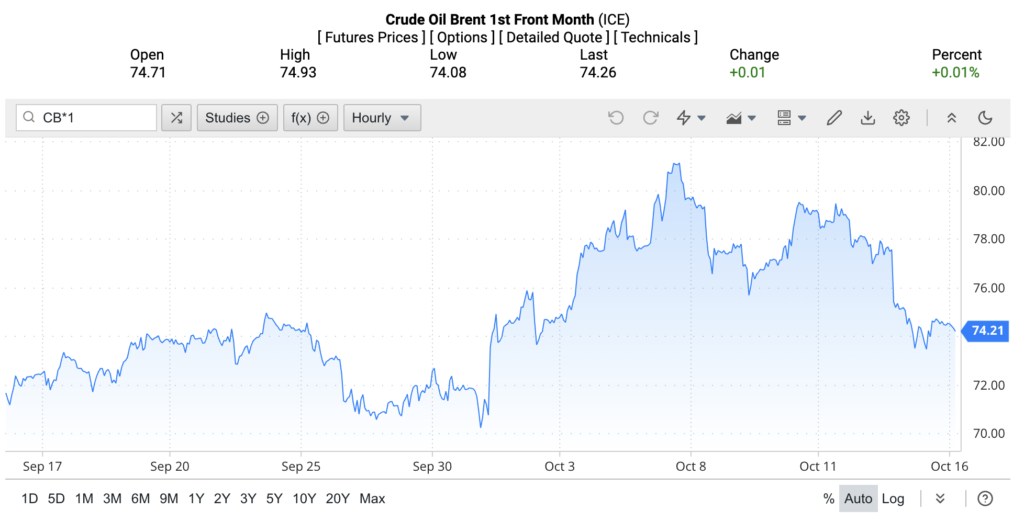Crude Oil Market Overview for Retail Traders – October 2024
As of October 2024, the crude oil market is experiencing a significant period of volatility, presenting both risks and opportunities for retail traders. West Texas Intermediate (WTI) crude oil recently fell to around $70 per barrel, with bearish sentiment continuing as technical support levels are tested. The market remains under pressure due to weak demand and macroeconomic headwinds, but potential supply disruptions, particularly related to geopolitical tensions in the Middle East, have caused recent price spikes and increased uncertainty.
The U.S. Energy Information Administration (EIA) has adjusted its crude oil price forecast downward, with Brent crude expected to average around $78 per barrel in 2025, reflecting lower-than-expected demand growth globally. However, these projections remain subject to change depending on the evolving geopolitical landscape and potential supply constraints. For retail traders, this means staying cautious, as crude prices could either stabilize or continue fluctuating, depending on supply-demand dynamics and international developments.
Retail traders should closely monitor technical indicators and key market events to gauge potential price movements. For more detailed analysis, you can visit FXEmpire or check out the EIA’s October Short-Term Energy Outlook for a more comprehensive market overview.

1. Current Market Conditions
In October 2024, crude oil prices are hovering around $75-$85 per barrel, with significant fluctuations. Prices have been volatile, reflecting shifts in supply-demand balances, changes in production policies from key oil-producing nations, and macroeconomic uncertainties.
- OPEC+ Output Decisions: The Organization of Petroleum Exporting Countries and its allies (OPEC+) have remained a key driver of prices. In 2024, OPEC+ has been navigating a delicate balance between supporting prices and maintaining market share, leading to periodic production cuts. Retail traders should monitor OPEC+ meetings for potential production decisions that could drive prices up or down.
- U.S. Shale Production: U.S. shale producers have been slower to ramp up production despite higher prices, as investors continue to prioritize capital discipline and returns to shareholders. This has limited the potential supply growth from the U.S., supporting higher prices.
2. Demand Factors
- Global Economic Outlook: The global economy is experiencing slower growth due to continued inflationary pressures, central bank rate hikes, and potential recessions in key economies such as the Eurozone and China. These economic conditions have tempered global oil demand growth, leading to mixed signals about future price movements.
- China: China remains the largest importer of crude oil, and its economic recovery has been slower than expected following the pandemic and other economic challenges. Traders should monitor Chinese import data and GDP growth for any potential demand-driven price changes.
3. Geopolitical Risks
- Middle East Tensions: Geopolitical tensions in the Middle East, particularly involving major oil producers such as Iran and Saudi Arabia, continue to create supply-side risks. Any potential conflicts or disruptions in production could lead to sharp price spikes. Retail traders should keep an eye on political developments in this region, which often have immediate impacts on global oil supply.
- Sanctions and Trade Restrictions: Sanctions on Russian oil, following the ongoing geopolitical crisis, have also contributed to market tightness. Russian crude has been diverted to Asia at discounted rates, but Western sanctions have still caused supply bottlenecks.
4. Technological and Environmental Factors
- Transition to Renewables: Over the long term, the global transition to renewable energy and electric vehicles (EVs) is expected to dampen demand for fossil fuels. However, in the short-to-medium term, oil will continue to play a central role in the global energy mix, especially in regions with slower renewable adoption.
- Technological Innovation in Oil Production: Improvements in drilling technology and enhanced recovery methods could lead to more efficient production, potentially increasing supply and capping price gains.
Outlook for the Coming Months
Short-Term Expectations (October – December 2024)
Retail traders should expect continued volatility through the end of the year. Several key factors will shape crude oil prices in the short term:
- OPEC+ Adjustments: OPEC+ may decide to adjust production levels to stabilize the market if prices drop too far below $85/barrel. An unexpected production cut could quickly drive prices back up.
- Winter Demand: Historically, oil demand tends to increase in the winter months due to heating needs, particularly in the northern hemisphere. However, the extent of this demand increase will depend on weather conditions and economic factors.
- Geopolitical Events: Any flare-ups in the Middle East, sanctions changes, or new trade policies could provide sudden shocks to supply and drive price volatility.
Medium-Term Expectations (2024 – Mid-2025)
In the medium term, prices may soften somewhat if global economic growth continues to slow, particularly in key markets like China. If central banks, including the Federal Reserve, maintain or increase interest rates to combat inflation, it could dampen overall oil demand by slowing economic activity.
- Potential Price Range: Prices could fluctuate between $75 and $105 per barrel, depending on demand and supply factors, OPEC+ policy, and global economic health.
Retail Trader Strategy Recommendations
- Monitor Key Indicators: Retail traders should track economic indicators such as U.S. inflation, global GDP growth, and OPEC+ output decisions to anticipate price changes. The release of weekly U.S. oil inventories and monthly OPEC reports are important data points for gauging short-term trends.
- Risk Management: Given the market’s volatility, traders should adopt a disciplined risk management strategy. Using tools like stop-loss orders, hedging, and position sizing can help mitigate risk in this uncertain environment.
- Diversification: Consider diversifying investments across energy commodities and sectors. While crude oil can offer opportunities, it’s important not to be overly exposed to a single asset class in a volatile market.
- Stay Informed on Geopolitics: Keeping up to date with geopolitical developments is crucial. Unexpected events, such as new sanctions, military conflicts, or trade disruptions, could have immediate and significant impacts on prices.
Conclusion
The crude oil market in October 2024 is at a crossroads, with high levels of uncertainty driven by supply-demand imbalances, economic headwinds, and geopolitical risks. Retail traders should expect continued volatility in the coming months but can navigate these conditions by staying informed, managing risks effectively, and maintaining a diversified approach to energy investments.
By monitoring key factors like OPEC+ decisions, geopolitical tensions, and economic data, traders can position themselves to take advantage of price movements while minimizing risks in a highly uncertain market.
This MyArkade blog is intended to provide general information. Our commentary is based solely on historical data and analyst research, using an impartial methodology. The content is not meant to serve as financial advice and should not be considered a recommendation to buy or sell any stock. It does not take into account your personal objectives or financial situation. Our goal is to offer long-term, data-driven analysis grounded in fundamental information. Please note that our analysis may not reflect recent company announcements or qualitative factors. MyArkade holds no positions in any of the stocks discussed.











